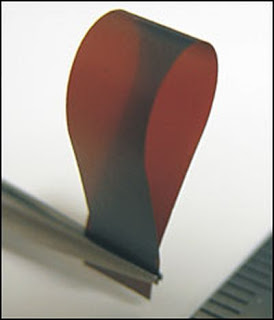Ruoff's research team was the first to develop graphene-based composite materials, which was reported in Nature last year. Graphene -- a sheet of carbon only one atom thick -- has the potential to serve as the basis of an entirely new class of materials.
“The mechanical, thermal, optical and electrical properties of graphene are exceptional,” says Ruoff. “For example, the stiffness and strength of these graphene-like sheets should be superior to all other materials, with the possible exception of diamond.”
To form the graphene oxide paper, the group oxidized graphite to create graphite oxide, which falls apart in water to yield well-dispersed graphene oxide sheets. After filtering the water, the team was able to fabricate pieces of graphene oxide 'paper' more than five inches in diameter and with thicknesses from about one to 100 microns, in which the individual micron-sized graphene oxide sheets are stacked on top of each other.
“I have little doubt that very large-area sheets of this paper-material could be made in the future,” Ruoff notes.
In addition to their superior mechanical properties as individual sheets, the graphene oxide layers stack well, which could be key to the development of other materials.
“You can imagine that these microscale sheets may be stacked together and chemically linked, allowing us to further optimize the mechanical properties of the resulting macroscale object,” Ruoff says. “This combination of excellent mechanical properties and chemical tunability should make graphene-based paper an exciting material.”
Of further interest are the electrical properties of the graphene oxide paper in comparison to graphene sheets. “When we oxidize the graphene sheets to create graphene oxide, the material goes from being an electrical conductor to an electrical insulator,” Ruoff says. “This is an important step and in the future it will be possible to tune the material as a conductor, semiconductor or insulator. One will be able to control the electrical properties without sacrificing exceptional mechanical properties.”
Ruoff sees a wide variety of application for graphene oxide paper, including membranes with controlled permeability, and for batteries or supercapacitors for energy applications. Graphene oxide paper could also be infused to create hybrid materials containing polymers, ceramics or metals, where such composites would perform much better than existing materials as components in, for example, airplanes, cars, buildings and sporting goods products.
The development of this paper-like material is the latest of several recent advancements by Ruoff's team in launching the new field of graphene-based materials. In a paper in the July issue of Nano Letters, the group reported that graphene sheets could be embedded into glass films to make them electrically conductive. These transparent thin films could find applications in solar cells or a variety of transparent electronics such as electronic paper and flexible color screens. The processing of these films may provide a cheaper alternative to the widely used indium tin oxide coatings that are typically used as the transparent conductive film.
In addition to Ruoff, other authors on the Nature paper are Dmitry Dikin, Sasha Stankovich, Eric Zimney, Richard Piner, Geoffrey Dommett, Guennadi Evmenenko and SonBinh Nguyen. For the Nano Letters paper, this group of researchers was also joined by coauthors Supinda Watcharotone, and from the National Cheng Kung University in Taiwan, Shang-En Wu, Shu-Fang Chen and Chuan-Pu Liu.
The work reported in Nature and in Nano Letters was supported by NASA and the National Science Foundation.
Contact: Megan Fellman fellman@northwestern.edu 847-491-3115 Northwestern University
Technorati Tags: Nano or Nanotechnology and Nanotech and Graphene oxide paper or Northwestern University and transparent conductive film or Scientists Discover New Way to Study Nanostructures and "I want you" Uncle Sam and Presidential Podcast 08/04/07















No comments:
Post a Comment